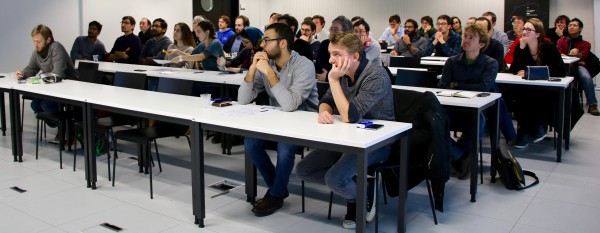MARVEL Junior Seminar — June 2021
Zoom meeting link:
https://epfl.zoom.us/j/93881551248
Password: 3417
The MARVEL Junior Seminars aim to intensify interactions between the MARVEL Junior scientists belonging to different research groups.
Each seminar consists of two presentations of 25 minutes each, allowing to present on a scientific question in depth, followed by time for discussion. The discussion is facilitated and timed by the chair.

MARVEL Junior Seminar Organizing Committee — Michele Kotiuga, Sara Fiore, Stefano Falletta, Kristians Cernevics, Max Veit and Patrick Mayor
Talk 1 — Diffusio-osmotic transport of hydrophobic solutes and slippage opacity of two-dimensional materials
Maria Bilichenko, Gabriele Tocci, Marcella Iannuzzi
Department of Chemistry, University of Zurich
Understanding the nature of the interactions of liquids on solid surfaces is key to achieve molecular control over solute transport at aqueous interfaces in nanofluidics and, therefore, can lead to important advances for water purification. We propose a framework to compute the diffusio-osmotic transport of hydrophobic particles at aqueous interfaces from equilibrium molecular dynamics simulations by combining the Stokes equation of hydrodynamics with the theory of the hydrophobic effect [1]. We describe the free energy of hydration of small solutes from the probability of formation of a cavity at the interface. Within this model, the fluid velocity is obtained according to Stokes equation[2], which is modified to account for the liquid/solid friction, resulting in water slippage. We apply this framework to investigate the diffusio-osmotic transport of small hydrophobic solutes at several aqueous interfaces of interest in nanofluidics by means of extensive ab initio molecular dynamics simulations. In particular, we focus on the aqueous single and bilayer graphene, hBN and MoS2 interfaces, as well as their bilayer heterostructures. We show that, despite the adsorption free energy on different interfaces remains the same, the diffusio-osmotic coefficient of the hydrophobic particle can change a lot. For instance, it is around an order of magnitude larger when water is in contact with graphene with respect to when it is in contact with MoS2. Therefore, we conclude that the diffusio-osmotic coefficient is heavily controlled by slippage, which can be very different and is influenced only by the layer being in direct contact with water. Our work is a first step into the design from first principles of materials which promote fast water slippage for applications in coatings and water purification nanofluidic membranes.
[1] D. Chandler, Nature, 2005, 437, 640-647
[2] A. Ajdari, L. Bocquet, PRL, 2006, 96, 186102, 1-4
Talk 2 — 2D materials for future field-effect transistors under the ab initio microscope
Cedric Klinkert1, Áron Szabó1, Christian Stieger1, Mathieu Luisier1, Davide Campi2, Nicola Marzari2
1 Integrated Systems Laboratory, ETHZ
2 Theory and Simulation of Materials (THEOS) , EPFL
Single-layer 2D materials appear as excellent contenders to extend Moore’s scaling law beyond the silicon FinFETs thanks to their surfaces free from dangling bonds and their excellent electrostatic control. However, experimental efforts using e.g. transition metal dichalcogenides (TMDs), have not yet reached the desired device performance.
A recent study based on density functional theory (DFT) could change the situation. It predicted the existence of more than 1800 exfoliable 2D candidates, among which several could play a role in the future of the semiconductor industry. From this database, we selected one hundred suitable materials for field-effect transistor (FET) applications. By combining ab initio calculations with an advanced Non-equilibrium Green’s function simulator we extracted relevant device metrics from 100 different single-gate 2D FETs designed according to the prescriptions of
the International Roadmap for Devices and Systems (IRDS).
In total, we found 13 promising candidates that could theoretically outperform the projected silicon FinFET “current vs. voltage” characteristics for 2025 by up to a factor of 2. The best materials often possess a single anisotropic valley in the conduction or valence band. To shed light on the behavior and limitations of such 2D monolayers, we investigated the performance of a representative example, black phosphorus, in great detail.
Check the list of the next MARVEL Junior Seminars here.
Low-volume newsletters, targeted to the scientific and industrial communities.
Subscribe to our newsletter